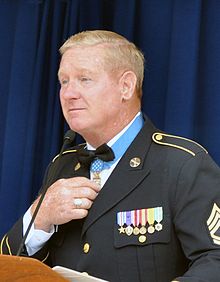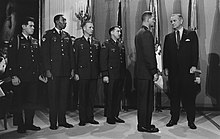
David Charles Dolby was a United States Army soldier who received the U.S. military's highest decoration, the Medal of Honor, for his actions in the Vietnam War.

James William "Jim" Robinson Jr. was an American soldier and a posthumous recipient of the Medal of Honor. Robinson earned the award while serving with the U.S. Army in Vietnam. He was a Sergeant (E-5) in the infantry when he was killed under heroic circumstances on April 11, 1966, at age 25.
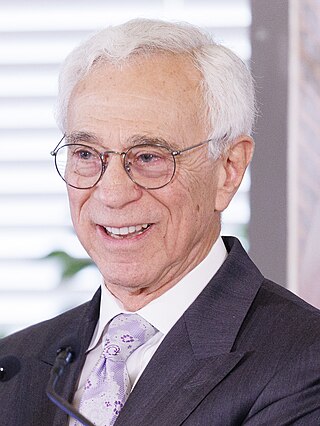
Jack Howard Jacobs is a retired colonel in the United States Army and a Medal of Honor recipient for his actions during the Vietnam War. He serves as a military analyst for NBC News and MSNBC and previously worked as an investment manager.

Alfredo Cantu "Freddy" Gonzalez was a United States Marine Corps Sergeant who posthumously received the Medal of Honor for service in the Battle of Huế during the Vietnam War.

Charles Calvin Rogers was a US Army officer and a recipient of the highest military decoration in the United States, the Medal of Honor, for his actions during the Vietnam War.

Maximo Yabes born in Lodi, California, was a United States Army soldier who posthumously received the Medal of Honor — the United States' highest military decoration — for his actions near Phu Hoa Dong in South Vietnam during the Vietnam War. Yabes distinguished himself when he used his body as a shield to protect others in a bunker, moved two wounded men to a safer position where they could be given medical treatment and destroyed an enemy machine gun position before being mortally wounded.
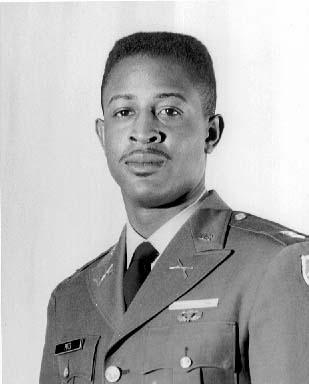
Riley Leroy Pitts was a United States Army captain and the first African-American officer to receive the Medal of Honor. The medal was presented posthumously by President Lyndon B. Johnson on December 10, 1968 for actions in Ap Dong, Republic of Vietnam.

Gary Burnell Beikirch was a United States Army soldier who received the United States military's highest decoration, the Medal of Honor, for his actions during the Vietnam War. A combat medic, Beikirch was awarded the medal for exposing himself to intense fire in order to rescue and treat the wounded, and for continuing to provide medical care despite his own serious wounds, during a battle at Dak Seang Camp.
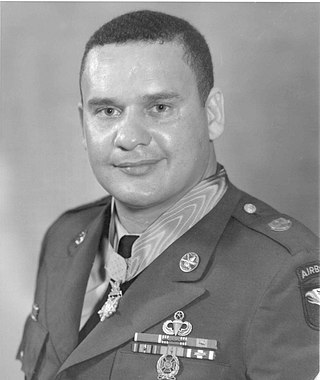
Webster Anderson was a United States Army soldier and a recipient of America's highest military decoration—the Medal of Honor—for his actions in the Vietnam War.

Donald Russell Long was a United States Army soldier and a recipient of America's highest military decoration—the Medal of Honor—for his actions in the Vietnam War.
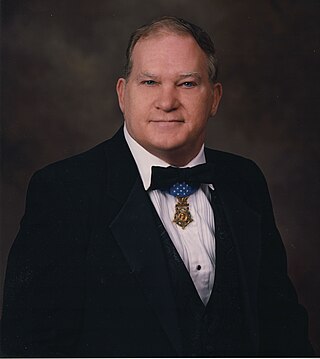
John Franklin Baker Jr. was a United States Army Master Sergeant who served in the Vietnam War and a recipient of the Medal of Honor.

Lester Raymond Stone Jr. was a United States Army soldier and a recipient of the United States military's highest decoration—the Medal of Honor—for his actions in the Vietnam War.

Paul Ronald Lambers was a United States Army soldier and a recipient of the United States military's highest decoration—the Medal of Honor—for his actions in the Vietnam War.

Leonard Bert Keller was a United States Army soldier and a recipient of the United States military's highest decoration—the Medal of Honor—for his actions in the Vietnam War.

Delbert Owen Jennings was a United States Army soldier and a recipient of the United States military's highest decoration—the Medal of Honor—for his actions in the Vietnam War.

John Noble Holcomb was a United States Army soldier and a recipient of the United States military's highest decoration—the Medal of Honor—for his actions in the Vietnam War.

Robert John Hibbs was a United States Army officer who graduated from the University of Northern Iowa and was a recipient of the United States military's highest decoration—the Medal of Honor—for his actions in the Vietnam War.

Harold Bascom Durham Jr. was a United States Army officer and a recipient of the United States military's highest decoration—the Medal of Honor—for his actions in the Vietnam War.
Operation Kien Giang 9-1 was a joint U.S. and Army of the Republic of Vietnam (ARVN) operation in Dinh Tuong Province from 16–19 November 1967.

Paris D. Davis is a retired United States Army officer who received the Medal of Honor on 3 March 2023 for his actions on 18 June 1965 during the Vietnam War. He was twice previously nominated for the Medal of Honor, but both times the paperwork relating to his nomination disappeared. Davis, then a captain with the 5th Special Forces Group, was instead awarded the Silver Star. He subsequently commanded the 10th Special Forces Group.
